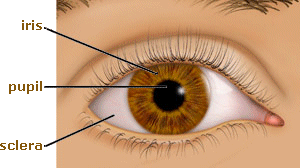I am so excited to take part in this, my second, A – Z Challenge! Last year I did the challenge using “recipes” as my inspiration. Well, this year I’m going to draw on my nursing background and use “parts of the human body” as my inspiration! Hmmm…a part of the body that starts with “Q”, “X” or “Z”….
It should be a lot of fun and I’m looking forward to seeing how everyone interprets the Challenge!
So, without further ado, “I” is for Iris:

Image is from the Ted M. Montgomery (Optometric Physician) website.
The iris, visible through the eye’s clear cornea, is a thin, circular structure in the eye. It responsible for controlling the diameter and size of the pupil and thus the amount of light reaching the retina.
“Eye colour”, which is genetically determined, is governed by the amount of pigment present in the iris structure. No pigment at all (in the case of an albino) results in a pink iris. Some pigment causes the iris to appear blue. Increasing and varied amounts of iris pigment produce green, hazel, grey, violet and brown irises.
“I” is also for:
ileocecal valve A modification of the mucosa at the junction of the small and large intestine that forms a one-way passage and prevents the backflow of food materials.
ileum The terminal portion of the small intestine between the jejunum and cecum.
internal ear The innermost portion or chamber of the ear, containing the cochlea and the vestibular organs.
interstitial cells Cells located in the interstitial tissue between adjacent convolutions of the seminiferous tubules of the testes; they secrete androgens (mainly testosterone); also called cells of Leydig.
intervertebral disc A pad of fibrocartilage located between the bodies of adjacent vertebrae.
incus The middle of three auditory ossicles within the middle-ear chamber; commonly called the anvil.
That’s a few more parts of the body that start with the letter “I”, but, there are even more! Check them out at the McGraw-Hill Applied Biology Resource Center website.
The information contained in this post was obtained from Anatomy, Physiology and
Pathology of the Human Eye, Wikipedia and McGraw-Hill Applied Biology Resource Center.












‘I’ is also for IQ, and mine has just risen by a few points having read your blog. Thanks!
haha…well Becky, I don’t know about that, but thanks!!
Iris – is usually one of the first things we notice, on people we meet. ‘I’ t helps us to gauge their reaction to us, too. All very ‘i’mportant body parts. Great ‘I’ post!
Kathy at Oak Lawn Images
How true Kathy, it is one of the first things we notice! {PS..I also noticed how clever you are!}
Very informative! I love learning new medical information. Thanks for the great post. :)
Thanks Devin, I’m happy you are enjoying my theme!
Monica, Older Mommy Still Yummy
Oh, I love your theme, because I love learning, of course.
Miranda, I’m glad you like the theme…and learning! Thanks for visiting me and I hope you’re having fun with the Challenge.
Monica, Older Mommy Still Yummy
And “Iris” is also one of my favorite Goo Goo Dolls songs! Hazel eyes for me. :)
Exactly…I love that song!! Green for me…we have lots of eye pigment!